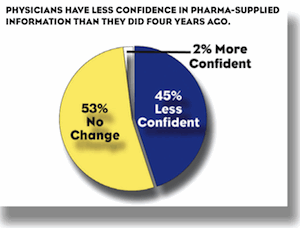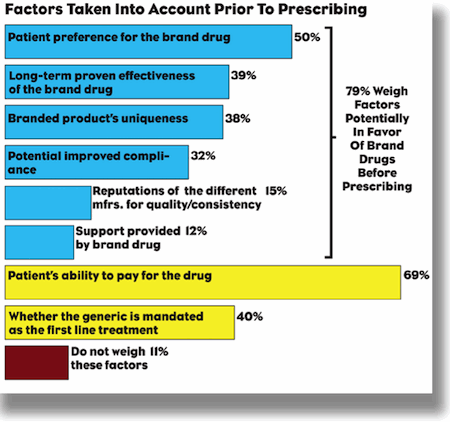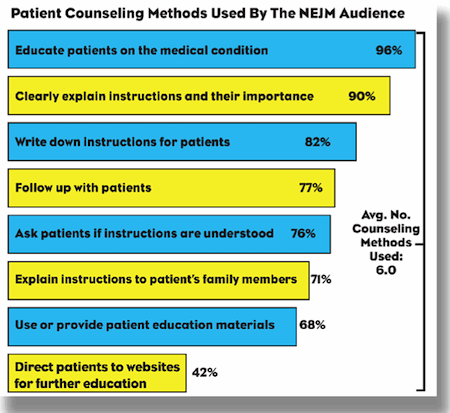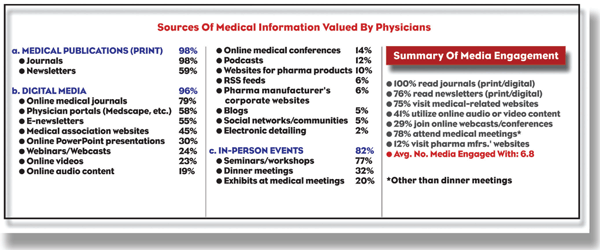The Research Study:
This article is based on an online survey of the audience of The New England Journal of Medicine, entitled How Physicians Learn and Make Decisions About Drug Therapy. Conducted by Martin Akel & Associates in late 2010, it reflects the responses of 1,480 actively practicing physicians in 14 medical specialties, office and institutionally-based (including cardiologists, oncologists, hematologists, internists, family medicine practitioners, et al). An executive summary and additional data from the study are available from The New England Journal of Medicine, NEJMsurvey@pm360online.com.
It wasn’t that long ago when bringing products to the physician market seemed relatively simple. The obstacles (e.g., generics, direct competitors, etc.) were fewer. And making physician contact was far more straightforward—detail reps, journal ads, and perhaps an Rx pad and an exhibit or two.
That may be a simplification. But new research sponsored by The New England Journal of Medicine measures just how complex the issues have become, and suggests contemporary solutions.
Trends Affecting Successful Marketing of Rx Products
Physicians have grown more skeptical. Almost half the physicians studied are now less confident (than they would have been four or five years ago) in claims made by pharma companies about their prescription drugs.
Non-adherence to therapies. Nine of ten physicians (89%) state that patient noncompliance with drug therapy is “significant” in their practices.
Shorter periods of marketing exclusivity. The time between first-in-class drugs and follow-on drugs has fallen dramatically…from 10.2 median years in the 1970s, to 2.5 years in the early 2000s, according to the Tufts Center for the Study of Drug Development.
Weighing brands against generics.
When both a brand and generic drug are available for a patient’s condition, most physicians (89%) consciously consider specific factors in favor of or in opposition to each type of product.
Yes, it is getting harder to get in to see prescribers. Compared to three or four years ago:
- 65% of physicians have less time to see detail reps.
- 69% are seeing fewer reps.
- Office-based physicians see just 3.5
reps per week; institutional-based see only 0.9 per week.
Contact requires a mix of multiple, non-personal media. Each physician now values 6.8 different types of professional media.
Driving Physicians through the Product Adoption Process
Given the above market conditions, achieving brand success requires:
- Identifying the highest influence physicians…those who can have the greatest impact on a brand’s credibility, acceptance and growth.
- Using non-personal media to move high influence physicians through all phases of the product adoption process.
The Four Successive Phases of the Product Adoption Process
Phase 1 – Awareness:
Generating awareness of a product’s existence.
Phase 2 – Perceptions:
Establishing impressions of what the product stands for.
Phase 3 – Positioning:
Establishing the brand’s differences versus competitive products.
Phase 4 – Preference:
Establishing preference for product evaluation or trial when next treating an appropriate patient.
Identifying high influence physicians
Using The New England Journal of Medicine’s audience, we asked detailed questions to determine the characteristics of “high influence” physicians. These include their personal influence in the practitioner community and their direct impact on patient therapy selection.
To assess physicians’ personal influence in the medical community, the study measured:
- Influence as opinion leaders. 79% of those studied are sought out by other healthcare professionals for advice on clinical issues and approaches, on a daily or weekly basis.
- Influence at medical meetings. 81% attended national meetings in the last 24 months, and almost half (42%) have proactive roles at national, regional or local meetings (speakers, moderator or chairs).
- Influence through the peer reviewed medical media. Within the last 36 months, almost half (42%) have published, edited, reviewed journal articles, been interviewed for articles, or served on media advisory boards.
- Influence as clinical trial investigators. In the last 36 months, 30% have been lead or co-lead investigators in clinical trials (an average of 7.7 trials per physician).
- Influence on formulary/P&T committee decisions. One third (30%) are involved with formulary/P&T committees at MCOs, hospitals, etc.

Direct Influence on Drug Selection in Day-to-Day Patient Care
And, in gauging doctors’ direct influence on drug selection in day-to-day patient care, the study found:
- Assertive attitudes about therapeutic options. Eighty-nine percent indicated it’s very important or important to learn new drug treatment information, and 87% specifically state that it’s important to examine the full range of alternative solutions for patients.
- Influence on the early adoption of new drugs. Two-thirds (67%) are early adopters or in the early majority of the adoption of new drugs— prescribing them while they’re in clinical trials (7%), soon after release (33%) or after a few colleagues try them successfully (27%).
- Influence on the selection of branded vs. generic drugs. When both brand and generic options are available— prior to prescribing, eight of ten specifically weigh factors that are potentially favorable for branded products.
- Influence as advocates for their drugs of choice. When respondents believe a specific drug is the best course of treatment for a patient (but it is not on formulary), most take action to see that patients gain access to the drug. For example: 80% use an appeals process; 59% request the drug be added to the formulary; and 40% suggest the patient pay out of pocket.
- Influence on compliance with drug therapies. And most of those studied use multiple counseling methods to enhance adherence to drug therapies.
Marketing Today Requires a Mix of Print, Digital and In-Person Media
An expanded “pie” of time. Compared with three or four years ago, half of high influence physicians (50%) now spend even more time accessing/ reviewing sources of medical information… allowing time for both traditional and new media.
Physicians continue to consume medical journals. Respondents read an average of 7.5 journals per month (print + online journals).
Engaging with a variety of types of media. Of the 21 types of media studied, high influence physicians now value 6.8 different types each—requiring marketers to address them on their own terms, via the many resources they’ve embraced.



Embracing Multiple Media
Attitudes towards a prominent journal (The New England Journal of Medicine) illustrate physicians’ desire to be addressed via multiple media.
- 95% of its audience welcomes the fact that the journal makes content available via a full suite of media (print, online, e-newsletter, videos, etc.).
- On average, each audience member engages the journal through four different types of media, with 96% engaged with one or more types of digital content.
In summary, the data show that the environment for addressing the physician market is more formidable than ever. Therefore, marketing requires identifying and contacting the highest influence physicians…those who have influence throughout the medical community as well as on drug selection in day-to-day patient care. And marketing also requires employing a mix of non-personal media (both traditional and newly-established) to move physicians through all phases of the product adoption process.








